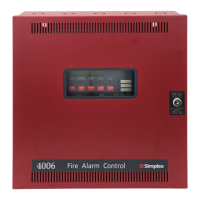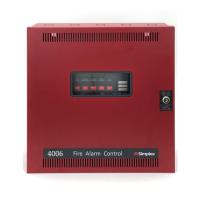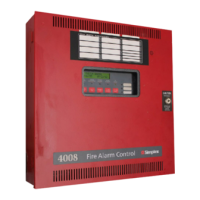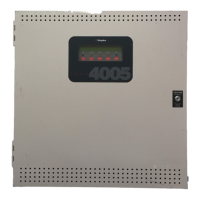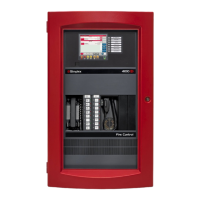







Do you have a question about the Simplex 4100ES and is the answer not in the manual?
Overview of the Simplex 4100ES Fire Alarm Control Panel (FACP) functions and components.
Describes the normal operational display and indicators on the FACP during standard operation.
Details the procedure for acknowledging fire alarm conditions on the FACP interface.
Explains how to silence audible notification appliances during an alarm event using the FACP.
Covers the process to reset the FACP after alarms, troubles, or supervisory conditions.
Describes how to inhibit alarm reporting for a malfunctioning point on the FACP.
Explains how the FACP indicates and identifies trouble conditions and their causes.
Details the procedures for acknowledging and clearing trouble conditions on the FACP.
Provides steps to follow when a trouble condition persists after acknowledgment.
Explains how the FACP indicates and identifies supervisory conditions.
Covers the procedure for acknowledging supervisory conditions on the FACP.
How to select points from active abnormal condition lists for monitoring/control.
Navigating the FACP menu system to select specific points for operation.
Using the keypad to quickly select points by category and address.
Managing user access levels and security through login/logout procedures on the FACP.
Procedure to correctly set the system's time and date for accurate logs and reports.
How to enable or disable system points, often for maintenance purposes.
Manually overriding point states for testing or specific control functions.
Accessing and managing historical alarm and trouble event logs on the FACP.
Creating various system reports for analysis and documentation from the FACP.
Procedure to activate Install Mode to minimize troubles during system installation.
Managing points, cards, and lists within the FACP's Install Mode list.
How to check which items are currently in Install Mode on the FACP.
Testing panel lamps and tone-alert functions for operational status.
Introduction to performing a one-person system walk test for initiating devices.
Configuring options for WalkTest groups, including logging and silent modes.
Testing line voltage for notification appliances connected to TrueAlert Power Supplies.
Disabling CO algorithms for testing purposes and managing sensor behavior.
Running self-tests on TrueAlert ES notification appliances for functionality.
Diagnosing field wiring quality and locating earth faults using the FACP.
Using the system for prerecorded or live audio announcements on one channel.
Playing prerecorded and live messages simultaneously on one channel.
Operating separate prerecorded and live audio messages on two channels.
Managing multi-channel audio systems for complex audio distribution.
Overview of the Simplex 4100ES Fire Alarm Control Panel (FACP) functions and components.
Describes the normal operational display and indicators on the FACP during standard operation.
Details the procedure for acknowledging fire alarm conditions on the FACP interface.
Explains how to silence audible notification appliances during an alarm event using the FACP.
Covers the process to reset the FACP after alarms, troubles, or supervisory conditions.
Describes how to inhibit alarm reporting for a malfunctioning point on the FACP.
Explains how the FACP indicates and identifies trouble conditions and their causes.
Details the procedures for acknowledging and clearing trouble conditions on the FACP.
Provides steps to follow when a trouble condition persists after acknowledgment.
Explains how the FACP indicates and identifies supervisory conditions.
Covers the procedure for acknowledging supervisory conditions on the FACP.
How to select points from active abnormal condition lists for monitoring/control.
Navigating the FACP menu system to select specific points for operation.
Using the keypad to quickly select points by category and address.
Managing user access levels and security through login/logout procedures on the FACP.
Procedure to correctly set the system's time and date for accurate logs and reports.
How to enable or disable system points, often for maintenance purposes.
Manually overriding point states for testing or specific control functions.
Accessing and managing historical alarm and trouble event logs on the FACP.
Creating various system reports for analysis and documentation from the FACP.
Procedure to activate Install Mode to minimize troubles during system installation.
Managing points, cards, and lists within the FACP's Install Mode list.
How to check which items are currently in Install Mode on the FACP.
Testing panel lamps and tone-alert functions for operational status.
Introduction to performing a one-person system walk test for initiating devices.
Configuring options for WalkTest groups, including logging and silent modes.
Testing line voltage for notification appliances connected to TrueAlert Power Supplies.
Disabling CO algorithms for testing purposes and managing sensor behavior.
Running self-tests on TrueAlert ES notification appliances for functionality.
Diagnosing field wiring quality and locating earth faults using the FACP.
Using the system for prerecorded or live audio announcements on one channel.
Playing prerecorded and live messages simultaneously on one channel.
Operating separate prerecorded and live audio messages on two channels.
Managing multi-channel audio systems for complex audio distribution.
| Type | Fire Alarm Control Panel |
|---|---|
| Display | LCD |
| Battery Backup | Yes |
| Model | 4100ES |
| Manufacturer | Simplex |
| Communication Protocol | Optional Ethernet |
| Signaling Line Circuits (SLCs) | Up to 10 |
| Notification Appliance Circuits (NACs) | Up to 10 |
| Agency Listings | UL, FM, CSFM, MEA |
| Max Relay Circuits | 20 |
| Communication Ports | Ethernet |
| Operating Temperature | 32°F to 120°F (0°C to 49°C) |
| Humidity | Up to 93% RH, non-condensing |




